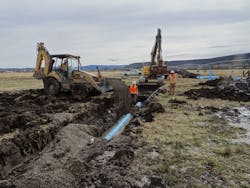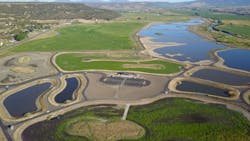About the author:
Michael Meyer is associate editor for WWD. Meyer can be reached at [email protected].
- Location: Prineville, Ore.
- Size: 2.31 mgd
- Infrastructure: Flocculation lagoons, treatment wetlands
Prineville, Ore., is a city of approximately 10,000 residents that is located in the center of the state in a scenic valley of the Blue Mountains region, just southwest of the Ochoco National Forest. Though Prineville’s population is modest compared to those of larger urban areas, it has nearly doubled since 1990. In response to the city’s growing need for wastewater management, its public works department developed the economical, eco-friendly Crooked River Wetlands Complex—an award-winning treatment concept that benefits the city’s residents in numerous ways.
Keeping Pace
By the mid-2000s, Prineville’s growth caused city officials to look into developing a mechanical treatment facility to replace its existing lagoon system, but the cost associated with such a project was estimated at $62 million. The city raised its system development charges (SDC) from approximately $3,800 to $9,147 per home to help pay for the facility, but this caused a sharp decline in growth, so another solution had to be found.
“We started looking at ways we could continue to use our lagoons, and what we found is that by constructing an effluent disposal wetland, it really works well with our existing lagoons and allows us to use that existing infrastructure way into the future,” said Eric Klann, public works director, city of Prineville.
In addition to the creating treatment and disposal wetlands near the lagoons, the public works department worked with a number of different community groups to determine how best to develop the habitat, provide recreational and educational opportunities, and control pests such as mosquitoes.
“At the end of the day, we constructed 120 acres of wetlands and 5.5 miles of trails, we have 13 educational kiosks that our local schoolchildren designed and worked with a graphic designer on, we did about 2 miles of riparian work to the Crooked River, and it’s just working out great,” Klann said. “It’s a really amazing project—we were able to go from that $62 million in 2005 dollars to about $7.75 million in 2016, and of that, $4 million was grants.”
The complex’s construction allowed the city to reduce its SDC to previous levels, which has played a role in renewing the city’s growth. Additionally, Klann projects that for the foreseeable future, the city’s wastewater rates will increase less than the consumer price index.
Treatment Trials
The facility uses flocculation lagoons to initially treat incoming wastewater. After the wastewater clears the lagoons, it is distributed either to a nearby golf course or to the treatment wetlands.
“Our treatment wetlands consist of a series of shallow and deeper ponds, so we go from an aerobic process to an anaerobic process and back to an aerobic process,” Klann said. “From there, we go to our disposal cells, and the disposal cells are designed to let the water infiltrate into the groundwater table, and then that cool, clean water pops up in the hyporheic zone of the Crooked River, and so we’re actually cooling the river through this indirect discharge.”
However, convincing environmental authorities of the project’s safety proved to be an ordeal. First, the Oregon Department of Environmental Quality (DEQ) created a management directive the city was required to follow, and then the U.S. EPA made its presence known.
“Once we were getting ready to construct it, EPA was brought in, and EPA really, really had a hard time accepting that indirect discharge,” Klann said. “EPA is all about the pipe going into the river and monitoring accordingly. So we did a lot of testing and groundwater monitoring for the first year; everything came back as we expected, and I think it was really a testimony that the city won EPA’s Pisces Award just recently based upon how well that system’s working and the environmental benefits of it.”
The city attempted to document the process as thoroughly as possible, so that it can help other municipalities that wish to create similar solutions.
“We were somewhat cutting edge on this process—how it was permitted and just the whole understanding of the indirect discharge—so one thing that we’ve really tried to do is develop massive amounts of data that will allow others not to have such an arduous path if they want to move forward,” Klann said.
Into the Future
Whereas a traditional mechanical plant likely would need to be periodically upgraded to deal with increasing wastewater flows, the Crooked River Wetlands Complex will provide residents of Prineville with affordable treatment for decades without significant additions. That is not to say that the complex will not change, however.
“Our future plans are to just continue to let the facility develop and grow,” Klann said. “It’s definitely a living organism out there, so we’re fluctuating water elevations to get different biodiversity in the site.”
For example, the public works department is experimenting with lowering and raising water levels at the site in order to attract different species of birds, which has been well received by birders in the area.
“As we move forward, we’ll just continue to monitor the site, and everything we’ve seen so far shows that we have a great solution that’s going to take care of water for the next 30 to 50 years for the city of Prineville,” Klann said.


